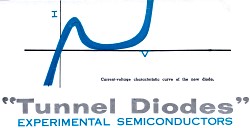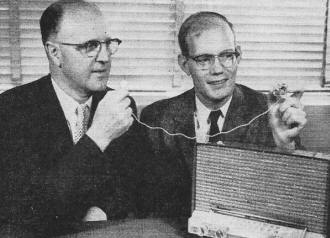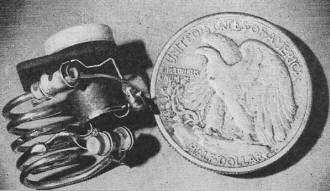"Tunnel Diodes" - Experimental Semiconductors
|
|
Tunnel diodes came onto the commercial, military, and aerospace scene in the late 1950s. Exploiting the phenomenon of quantum-mechanical tunneling, the device exhibits a negative resistance region which makes it suitable for amplifier and oscillator applications. It also permits operation into the tens of gigahertz realm, which was new ground at the time. X-band and above was the exclusive realm of laboratory-based experiments using klystrons and exotic chemical oscillators (pseudo-maser - microwave amplification by stimulated emission of radiation). Tunnel diodes quickly became a part of miniaturized radar units, battery-powered communications systems, undercover (spy) operations, and many other applications. "Tunnel Diodes" - Experimental Semiconductors
Dr. Guy Suits, G-E vice-president and director of research, speaks into microphone, while Dr. Jerome Tiemann holds the transmitter. In foreground, ordinary FM receiver picks up signal. Nestled inside a paper clip, a tunnel diode is shown in close-up view. Connecting wire leads to alloy soldered to germanium crystal which is soldered to metal plate. Vest-pocket transmitter, making use of a tunnel diode, and with a range of about one-half mile, is demonstrated by G-E scientists. The newest "baby" in the fast-growing family of semiconductor devices - the "tunnel diode" - is coming of age. The new device, first reported in 1958 by Japanese scientist Leo Esaki, is closer to commercial application as a result of intensive research programs at G-E and other companies. The special diode is a heavily doped junction semiconductor that has a negative-resistance characteristic over part of its operating range (see the graph above). The tunnel diode takes its name from the physical phenomenon that makes it possible: "quantum-mechanical tunneling." The term is used to describe the manner in which the electrical charges move through the device. Such motion takes place with the speed of light, in contrast to the relatively slow motion of electrical charge carriers in transistors. These high speeds make it possible for the device to operate at extremely high frequencies. Oscillation higher than 2000 mc. has already been obtained and frequencies of more than 10,000 mc. are expected in the near future. This high-speed response also- suggests applications in computers. When used as switches, tunnel diodes have functioned in a fraction of a millimicrosecond - from 10 to 100 times faster than the fastest transistor now available. A complete tunnel diode transmitter is compared in size with a 50-cent piece. The transmitter consists of one variable and two fixed ceramic capacitors, a coil that tunes to the operating frequency - which may be higher than 2000 mc. - and the diode itself, located inside the "can" in the center of the device. Battery is not shown. The device also resists the damaging effects of nuclear radiation. Because it is less dependent on the structural perfection of its crystal than is the transistor, it is much less affected by the damage that radiation can do to such crystal structures. In this respect it outranks transistors by more than 1000 to 1. Materials used for tunnel diodes include silicon, germanium, gallium arsenide, gallium antimonide, and indium antimonide. Silicon tunnel diodes work at temperatures 250°F higher than temperatures at which conventional silicon diodes and transistors operate. The negative-resistance characteristic allows the unit to be used as an amplifier, a generator of r.f. power, and a switching device. Its simplicity makes possible the development of integrated circuits. It is superior to vacuum tubes and transistors for applications in low-noise amplifiers and mixers for high frequencies. Many parametric amplifier jobs, for example, could be performed more easily with tunnel diodes. G-E now has plans to offer limited quantities of experimental samples in the next few months.
Posted August 8, 2018 |
|

 Insensitive to temperature changes and 100 times
faster than today's transistors, these devices bear watching.
Insensitive to temperature changes and 100 times
faster than today's transistors, these devices bear watching.

